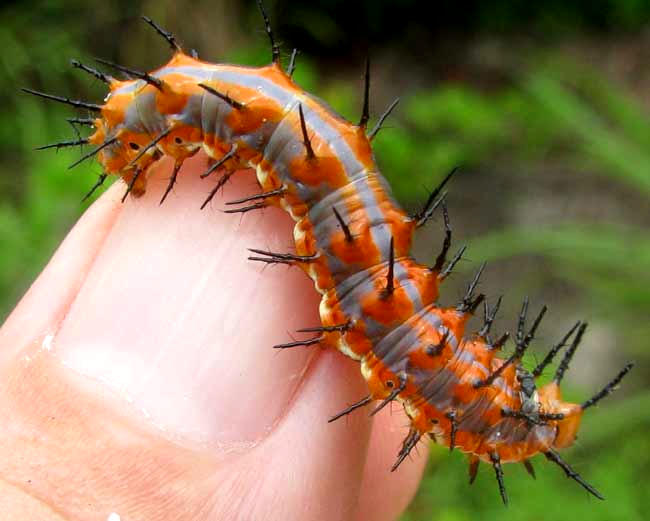Excerpts from Jim Conrad's
Naturalist Newsletter

from the August 7, 2011 Newsletter issued from Mayan Beach Garden Inn 20 kms north of Mahahual; Caribbean coastal beach and mangroves, ~N18.89°, ~W87.64°, Quintana Roo state, MÉXICO
CATERPILLAR CROSSING THE ROAD
Above you see the pretty, orange, silver-striped, black-spined caterpillar found crossing the white-sand road paralleling the beach. The sharp-looking, branched spines look like those of some stinging caterpillars but they're perfectly harmless, all bluff.
Since Bea our volunteer bug identifier is on vacation I almost didn't bother photographing our road caterpillar, knowing I'd not take the time to plow through the jillions of images answering to Google's image-query string "caterpillar orange black spines." However, then I remembered that around here we have only a relative handful of butterfly species, so why not just see if our road caterpillar is one of those?
As it turned out, the caterpillar belongs to our most common butterfly species, the Gulf Fritillary, whose orange and black markings are seen at www.backyardnature.net/yucatan/mariposa/butt086.jpg.
An even more eye-catching side view is shown at www.backyardnature.net/yucatan/mariposa/butt088.jpg.
The Gulf Fritillary caterpillar eats passion-flower vine, genus Passiflora, which grows very commonly among roadside trees here.
Most Gulf Fritillary caterpillars illustrated on the Internet lack the silvery lines so conspicuously extending the length of ours. In fact, caterpillars of this species can vary tremendously.
You might also enjoy a page nicely illustrating the Gulf Fritillary's development from egg to adult at http://www.floridanaturepictures.com/butterflies/butter25.html.